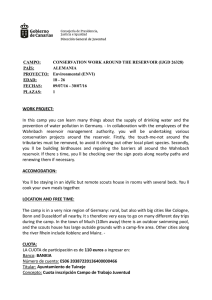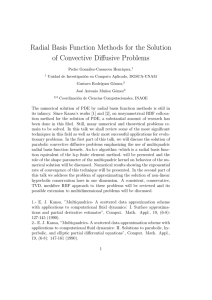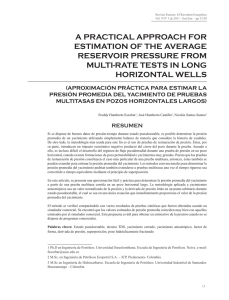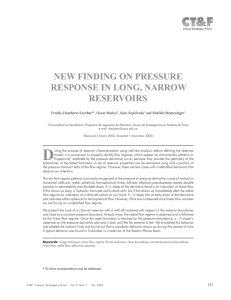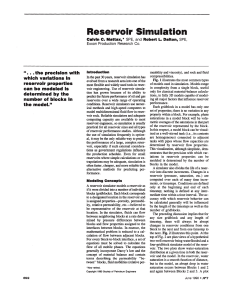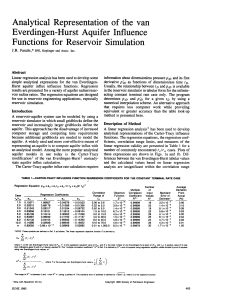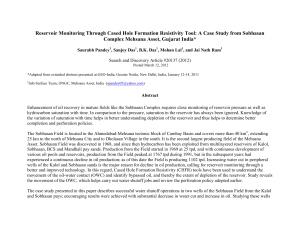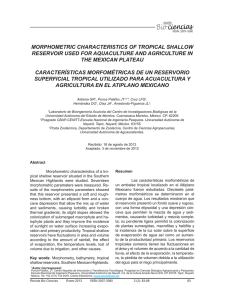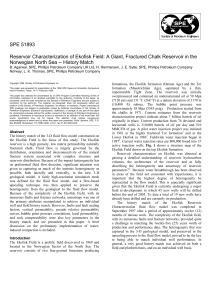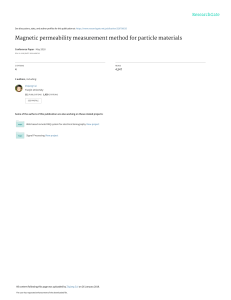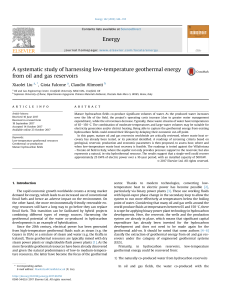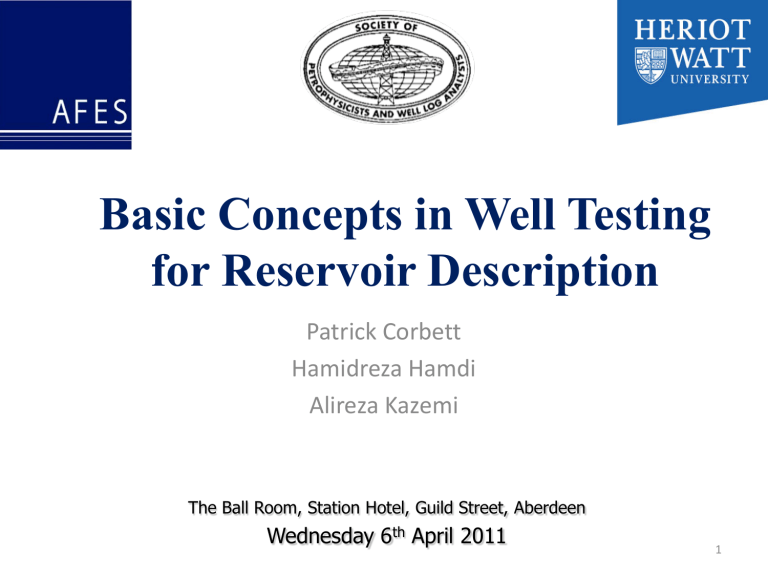
Basic Concepts in Well Testing for Reservoir Description Patrick Corbett Hamidreza Hamdi Alireza Kazemi The Ball Room, Station Hotel, Guild Street, Aberdeen Wednesday 6th April 2011 1 Introduction 2 Description of a well test Flow rate @ Surface Pressure @ Down-hole ∆PDD = Pi - P(t ) = ∆PBU P(t ) -= P( ∆t 0) Schlumberger 2002 1. During a well test, a transient pressure response is created by a temporary change in production rate. 2. For well evaluation less than two days. reservoir limit testing several months of pressure data 3 Well test objectives • Exploration well – On initial well, confirm HC existence, predict a first production forecast (DST: fluid nature, Pi, reservoir properties • Appraisal well – Refine previous interpretation, PVT sampling, (longer test: production testing) • Development well – On production well, satisfy need for well treatment, interference testing, Pav 4 Well test Types • Draw down – Open the well with constant rate decreasing bottom hole pressure • Build Up test – Shut-in the well increasing bottom hole pressure • Injection/ fall-off test ( different fluid type) – The fluid is injected increasing Bottom hole pressure – Shut-in the well decreasing the bottom hole pressure • Interference test / pulse test – Producing well measure pressure in another shut-in well away from the producer communication test • Gas well test – Back pressure , Isochronal test , modified isochronal test well productivity, AOFP, Non-Darcian skin. 5 Information obtained from well testing • Well Description – For completion interval (s), – Production potential (PI), and skin • Reservoir Description – – – – “Average” permeability (horizontal and vertical) Heterogeneities(fractures, layering, change of Prop.) Boundaries (distance and “shape”) Pressure (initial and average) • Note: Well Description and Reservoir Description – May be separate objectives 6 Methodology • The inverse problem P vs t Q vs t Reservoir • Model recognition (S) – Well test models are different from the geomodels in the sense that they are dynamic models and also it’s an average model. 7 Example: Interference test 1. Create signal at producing well 2. Measure the signal at both wells Observation well: 1. The signal will be received with a delay 2. The response is smaller 8 Fluid Flow Equation 9 concepts • • • • • • • • Permeability and porosity Storativity and Transmissibility Skin Wellbore storage Radius of investigation Superposition theory Flow regimes Productivity index (PI) 10 Concepts-Definitions • Permeability: – The absolute permeability is a measure of the capacity of the medium to transmit fluids. Unit: md (10-12 m2) • Transmissibility • Storativity T= Kh µ S = ϕ ct h • Diffusivity (Hydraulic diffusivity) • AOF • PI η= T S 11 Fluid flow equation: ingredients • Conservation of mass ( continuity equation) ∂ ∇( ρ • v ) = − ( ρφ ) ∂t • EOS, defining the density and changes in density with pressure 1 ∂ρ c= ρ ∂t • Transport equation ( Darcy’s law: experimental, or Navier-Stoke) 1 v = − K • ∇P µ 12 Fluid flow equation: radial case • Continuity + Darcy: in radial coordinate (isotropic) 1 ∂ r ρ kr ∂P ∂ = (ϕρ ) r ∂r µ ∂r ∂t • Assumptions: Radial flow into a well opened over entire thickness , single phase, slightly compressible fluid, constant viscosity , ignoring the gravity, constant permeability and porosity 1 ∂ ∂P ϕµ c ∂P r = r ∂r ∂r k ∂t 13 Solution to radial diffusivity equation • Inner/outer Boundary conditions: ∂p qµ B |r = ∂r w 2π khrw 1. Constant Pressure boundary, p=pi @re 2. Infinite reservoir p=pi @ ∞ 3. No flow boundary ∂p/∂r =0 @ re 14 Unsteady- Infinit acting reservoirs(radial flow regime): DD • Finite diameter well without WBS- infinite acting reservoir ∞ q 2 − u 2t D J 1 (u )Y0 (ur ) − Y1 (u ) J 0 (ur ) ∆P( r= ,t) 1−e du 2π T π ∫0 u 2 J 12 (u ) + Y12 (u ) ( ) ( ) q µ B 1 ϕµ cr 2 P( r , t ) = Pi − Ei − 2π kh 2 4kt Pi − Pwf (t ) = kt 162.6q µ B 3.23 0.87 S − + log 2 Kh ϕµ ct rw USS,PSS,SS? ∂P/∂t=f(x,t) USS (Well test) ∂P/∂t=cte PSS (boundary) ∂P/∂t=0 SS( aquifer) 15 Radius of investigation The radius of investigation ri tentatively describes the distance that the pressure transient has moved into the formation. ri = 0.032 k ∆t ϕµ ct Or it’s the radius beyond which the flux should not exceed a specified fraction or percentage of the well bore flow rate Can we use the radius of investigation to calculate the pore volume and reserve? 1. Based on radial homogeneous if fracture ? 2. Is it a radius or volume? 3. How about gauge resolution? 4. Which time we are talking about? 5. How about a close system? 6. How about the velocity of front? 16 Rate Rate Radius of investigation Q, T-dt Q=0, T-dt time time -Q, t -Q, dt Observation Pressure drop, at “r” Injection time 17 Skin Pressure Drop Skin Pressure drop: higher pressure drop near the well bore due to mud filtrate, reduced K , improved K, change of flow streamlines, fluid composition change,…. It is one of the most important parameter used in production engineering as it could refer to a sick or excited well and leads to additional work-over operations. Bourdet 2002 18 Wellbore Storage q Q(surface) Q(Sand face) Q(wellbore) log∆P, log∆P’ t Pure WBS Transition Radial FR In surface production or shut in the surface rate is controlled However due to compressibility of oil inside the well bore we have difference between sandface production and surface production It can affect the inner boundary condition and make the solution more complicated ∆V C= − = c0Vwb ∆P qB ∆t 24C Pure WBS ∆P( ∆t= ) Superposition • Effect of multiple well – ∆Ptot@well1=∑∆Pwells @well1 • Effect of rate change ∆Ptot = ∆P( q1−0) + ∆P( q 2− q1) + ... + ∆P( q 2− q1)@ tn −ti−1 • Effect of boundary ∆Ptot = ∆Pact + ∆Pimage • Effect of pressure change 20 Rate Rate Radius of investigation:superposition Q, T-dt Q=0, T-dt time time -Q, t -Q, dt Observation ∆Pr ,t = ∆Pr ,t 1 + ∆Pr ,t 2 −70.6( −q µ B ) −948ϕµ ct r 2 ∆Pr ,t 1 = Ei kh kt −70.6( q µ B ) −948ϕµ ct r 2 Ei ∆Pr ,t 2 = k ( t − ∆t ) kh −1694.4 µ ∆Pr ,t = e kht 948ϕµ ct r 2 tmax = k −948ϕµ ct r 2 kt Pressure drop, at “r” Injection time 21 Fluid flow equation : complexity • Linear , bilinear , radial, spherical • Depends on the well geometry, and reservoir heterogeneities • Change the fluid flow equation and the solution • The fluid heterogeneities affect the diffusivity equation and the solution ( non linearity gas res) 22 Derivative Plots 23 Transient Transition Derivative plot SS Transient Transition PSS PSS Reservoir Pore volume SS WBSTransition Matter 2004 24 Derivative plot : Example1 Structure effect on well testing Bourdet 2002 25 Derivative plot Example2 : Radial Composite Equivalent Homogeneous ΔP & ΔP’ K2<K1 Log(t) m2 ΔP m1 Composite m2 k2 = m1 k1 Log(t) 26 Derivative plot : Example3 : Horizontal Well Testing Example: Linear flow: 1 Vertical radial Sw 2 Linear flowSpp, Sw 3 Later radial flow ST=f(Sw,Spp,Sw,SG ,…) 27 Some sensitivities! Houze et al. 2007 28 Practical Issues • • • • • • • • • • • Inaccurate rate history Shut-in times Gauge resolution Gauge drift Changing wellbore storage Phase segregation Neighbouring well effect Interference Tidal effects Mechanical noise Perforation misties 29 Uncertain parameters • • • • • • • • • • • • • Complex permeability / porosity (higher order of heterogeneities) Complex thickness Complex fluid Wellbore effect? Any deviation from assumption New phenomena ? Gauge resolution Measurements? Correct rate history Numerical- Analytical Core-Log values ? Seismic? Averaging process? Layering response? Test design? Sensitivities? Multiple models ? How to make decision? 30 Rock Description 31 Core data evaluation • Summary numbers (statistics) for comparison with well tests • Variability measures • How do the numbers relate to the geology • How good are the summary numbers • How representative are the numbers 32 Measures of Central Tendency • Mean - population parameter • Average - the estimator of the population mean • Arithmetic average N 1 k ar = ∑ ki N i =1 • Geometric average k geom = ∏ ki i =1 N • Harmonic average 1 N 1 N k geom = exp ∑ log e ( ki ) N i =1 1 = N∑ i =1 k i N k har −1 33 Differences between averages Measures of heterogeneity k har ≤ k geom ≤ k ar Each permeability average has a different application in reservoir engineering 34 Averages in reservoir engineering • Used to estimate effective property for certain arrangements of permeability k ar k geom k har • Horizontal (bed parallel flow) k ar • Vertical and Horizontal (random) k har • Vertical (bed series flow) Remember these assumptions…. not the application!! 35 Comparing the well test and core perms. - kar - kgeom - 10-50ft 5-10ft 1-5ft • Need to consider the nature and scale of the layering in the volume of investigation of a well test khar 36 Well test comparison example Well A Core plug data Well B • Well A: Kar =400md ktest = 43md kgeom = 44md • Well B: Kar =600md ktest = 1000md Toro-Rivera et al., 1994 37 Permeability distributions in well Well A Well B Minor channels Major channels • NB: K data plotted on log AND linear scales 38 Well test comparison example WELL WELL A A XX10 XX20 WELL B WELL B 35m 55m Minor Channel XX55 LogK .01 LogK LinK LinK Major Channels 10k 0 2000 4000 Triassic Sherwood Sandstone Braided fluvial system (Toro Rivera, 1994,SPE 28828, Dialog article) 39 Core plug petrophysics WELLAA WELL 60 Count 70 Arith. av.: 400mD 60 Geom. av: 43mD 50 40 30 20 10 0 -6 -4 -2 0 2 4 6 8 10 12 WELL WELLBB Arith. av.: 625mD 50 Geom. av: 19.8mD 40 30 20 10 0 -6 -4 -2 0 2 4 6 8 10 Permeability distributions similar Permeability averages similar Effective permeability similar? 40 WT log-log plot WELL A WELL B WELL A ETR MTR LTR ∆P ∆P r r ETR MTR LTR WELL B Time ETR: Linear flow MTR: Radial flow (44mD) Negative skin LTR: OWC effect ETR: Radial flow? MTR: Radial flow (1024 mD) Small positive skin LTR: Fault? Well test response very different Geological interpretation? 41 Well Test Informed Geological Interpretation WELL A WELL A WELL WELL BB LogK LogK LinK LinK Many small channels Limited extent “Floodplain effective flow” INTERFLUVE Few large channels More extensive “Channel effective flow” INCISED VALLEY 42 ‘Well A’ ‘Well B’ Two different well test responses - same formation 43 Coefficient of variation • Normalised measure of variability SD Cv = k ar 0 < Cv < 0.5 Homogeneous 0.5 < Cv < 1 Heterogeneous 1 < Cv Very Heterogeneous Carbonate (mix pore type) (4) S.North Sea Rotliegendes Fm (6) Crevasse splay sst (5) Sh. mar.rippled micaceous sst Fluv lateral accretion sst (5) Dist/tidal channel Etive ssts Beach/stacked tidal Etive Fm. Heterolithic channel fill Shallow marine HCS Shall. mar. high contrast lam. Shallow mar. Lochaline Sst (3) Shallow marine Rannoch Fm Aeolian interdune (1) Shallow marine SCS Lrge scale x-bed dist chan (5) M ix'd aeol. wind rip/grainf.(1) Fluvial trough-cross beds (5) Fluvial trough-cross beds (2) Shallow mar. low contrast lam. Aeolian grainflow (1) Aeolian wind ripple (1) Homogeneous core plugs Synthetic core plugs 0 Very heterogeneous Heterogeneous Homogeneous 1 2 Cv < 0.5 for a normal distribution 3 4 44 Sample sufficiency • Representivity of sample sets • for a tolerance (P) of 20% • and 95% confidence level • Nzero or No = optimum no. of data points • Where Ns = actual no. of data points • Ps gives the tolerance N 0 = (10 • Cv ) Ps = 2 ( 200 • Cv ) Ns 45 Sample sufficiency • Representivity of sample sets • for a tolerance (P) of 20% • and 95% confidence level • Nzero or No = optimum no. of data points • Where Ns = actual no. of data points • Ps gives the tolerance N 0 = (10 • Cv ) Ps = For carbonates (high variability P=50%) 2 ( 200 • Cv ) Ns 2 ( ) N 0 = 10 4 • Cv 46 Comparison of Core and Test Perms Zheng et al., 2000 47 Lorenz plot • Order data in decreasing k/φ and calculate partial sums ∑ Fj = jJ j =1 k jhj ∑ iI kh i =1 i i ∑ Cj = jJ j =1 φj h j 1 Fj Transmissivity 0 0 0 Φj 1 Storativity ∑ iI φh i =1 i i I = no. of data points 48 Lorenz plot • Order data in decreasing k/φ and calculate partial sums ∑ j =1 k j h j 1 Fj Transmissivity 0 jJ Fj = Homogeneity ∑ iI kh i =1 i i ∑ Cj = jJ j =1 φj h j Lc = 0 0 0 Φj 1 Storativity ∑ iI φh i =1 i i 49 Lorenz plot >> Lorenz Coefficient • Order data in decreasing k/φ and calculate partial sums ∑ j =1 k j h j 1 Fj Transmissivity 0 j Fj = Heterogeneity ∑ i kh i =1 i i ∑ Cj = j j =1 φj h j Lc = 0.6 0 0 Φj 1 Storativity ∑ i φh i =1 i i 50 Unordered Lorenz Plot Reveals stratigraphic layering 51 Example Lorenz Plots Modified Lorenz Plot Lorenz Plot 1.00 1.00 0.90 0.90 0.80 0.80 0.70 0.70 0.60 0.50 kh kh 0.60 0.40 0.50 SPEED ZONES 0.40 0.30 0.30 0.20 0.20 Series1 0.10 Series1 0.10 0.00 0.00 0.20 0.40 0.60 Phih 0.80 1.00 0.00 0.00 Use them together 0.20 0.40 0.60 0.80 1.00 Phih 52 Hydraulic Units and Heterogeneity Rotated Modified Lorenz Plot ( Ellabed et al., 2001) 53 Heterogeneity and Anisotropy 54 Scale dependant anisotropy Rannoch anisotropy Grain Lamina Bed Parasequence kv/kh 1 .1 WB SCS HCS .01 Formation .001 10 -6 Probe Plug 10 -4 10 -2 10 0 Sample volume (m3) 10 2 10 4 Plug averages Probe average Estimate of kv/kh anisotropy depends on the scale of application 55 Kv controls vertical inflow Ebadi et al., 2008 ICV – Interval Control Valve 56 Putting it all together 57 Conclusions ?? • Well testing – Model driven – Simple Models – Averaging process K x h = 600mDft Where h = 60ft Which K = 10mD??? • Reservoir Description – Heterogeneous – Scale dependant – Upscaling challenge 58 References Bourdet 2002, Well-test Analysis: The use of advanced interpretation models, Elsevier Corbett and Mousa, 2010, Petrotype-based sampling to improved understanding of the variation of Saturation Exponent, Nubian Sandstone Formation, Sirt Basin, Libya, Petrophysics, 51 (4), 264-270 Corbett and Potter, 2004, Petrotyping: A basemap and atlas for navigating through permeability and porosity data for reservoir comparison and permeability prediction, SCA2004-30, Abu Dhabi, October. Corbett, Ellabad, Egert and Zheng, 2005, The geochoke test response in a catalogue of systematic geotype well test responses, SPE 93992, presented at Europec, Madrid, June Corbett, Geiger, Borges, Garayev, Gonzalez and Camilo, 2010, Limitations in the Numerical Well Test Modelling of Fractured Carbonate Rocks, SPE 130252, presented at Europec/EAGE, Barcelona, June Corbett, Hamdi and Gurev, Layered Reservoirs with Internal Crossflow: A Well-Connected Family of Well-Test Pressure Transient Responses, submitted to Petroleum Geoscience, Jan, abstract submitted to EAGE/Europec Vienna, June 2011 Corbett, Pinisetti, Toro-Rivera, and Stewart, 1998, The comparison of plug and well test permeabilities, Advances in Petrophysics: 5 Years of Dialog – London Petrophysical Society Special Publication. Corbett, Ryseth and Stewart, 2000, Uncertainty in well test and core permeability analysis: A case study in fluvial channel reservoir, Northern North Sea, Norway, AAPG Bulletin, 84(12), 1929-1954. Cortez and Corbett, 2005, Time-lapse production logging and the concept of flowing units, SPE 94436, presented at Europec, Madrid, June. Ellabad, Corbett and Straub, 2001, Hydraulic Units approach conditioned by well testing for better permeability modelling in a North Africa oil field, SCA2001-50, Murrayfield, 17-19 September, 2001 Hamdi, Amini, Corbett, MacBeth and Jamiolahmady, Application of compositional simulation in seismic modelling and numerical well testing for gas condensate reservoirs, abstract submitted to EAGE/Europec Vienna, June 2011 Hamdi, Corbett and Curtis, 2010, Joint Interpretation of Rapid 4D Seismic with Pressure Transient Analysis, EAGE P041 Houze, Viturat, and Fjaere, 2007 : Dynamic Flow Analysis, Kappa. Legrand, Zheng and Corbett, 2007, Validation of geological models for reservoir simulation by modeling well test responses, Journal of Petroleum Geology, 30(1), 41-58. Matter, 2004 : Well Test Interpretation, Presentation by FEKETE , 2004 Robertson, Corbett , Hurst, Satur and Cronin, 2002, Synthetic well test modelling in a high net-gross outcrop system for turbidite reservoir description, Petroleum Geoscience, 8, 19-30 Schlumberger , 2006, : Fundamental of Formation testing , Schlumberger Schlumberger ,2002: Well test Interpretation, Schlumberger Toro-Rivera, Corbett and Stewart, 1994, Well test interpretation in a heterogeneous braided fluvial reservoir, SPE 28828, Europec, 25-27 October. Zheng, Corbett, Pinisetti, Mesmari and Stewart, 1998; The integration of geology and well testing for improved fluvial reservoir characterisation, SPE 48880, presented at SPE International Conference and Exhibition, Bejing, China, 2-6 Nov. Zheng, 59
